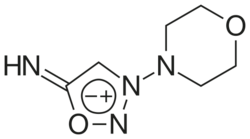Chemistry:Linsidomine
From HandWiki
Short description: Chemical compound
 | |
| Clinical data | |
|---|---|
| Other names | SIN-1 |
| AHFS/Drugs.com | International Drug Names |
| ATC code | |
| Identifiers | |
| |
| CAS Number |
|
| PubChem CID | |
| ChemSpider | |
| UNII | |
| KEGG | |
| Chemical and physical data | |
| Formula | C6H10N4O2 |
| Molar mass | 170.172 g·mol−1 |
| 3D model (JSmol) | |
| |
| |
| (verify) | |
Linsidomine (3-morpholinosydnonimine or SIN-1[1]) is a vasodilator. It is a metabolite of the antianginal drug molsidomine and acts by releasing NO from the endothelial cells nonenzymatically. It also hyperpolarizes the cell membrane through influencing the sodium-potassium pump and thereby rendering it less responsive to adrenergic stimulation. Linsidomine injection at a dose of 1 mg produces usable erection[2] in about 70% of patients and full erection in up to 50% of patients. Linsidomine does not appear to be associated with priapism.[citation needed]
Linsidomine is neurotoxic and promotes oxidative stress on neurons.[3] Linsidomine is a peroxynitrite-generating compound involved in the pathogenesis of neurodegenerative diseases.[4]
References
- ↑ "Cardiotrophin-1 protects cortical neuronal cells against free radical-induced injuries in vitro". Neuroscience Letters 387 (1): 38–42. October 2005. doi:10.1016/j.neulet.2005.07.018. PMID 16084018.
- ↑ "[Erectile response to intracavernous injection of linsidomine in 38 impotent patients. Comparison with prostaglandin E1]". Progres en Urologie 8 (3): 388–91. June 1998. PMID 9689672.
- ↑ "Estrogen attenuates gp120- and tat1-72-induced oxidative stress and prevents loss of dopamine transporter function". Synapse 59 (1): 51–60. January 2006. doi:10.1002/syn.20214. PMID 16237680.
- ↑ "Ergothioneine rescues PC12 cells from beta-amyloid-induced apoptotic death". Free Radical Biology & Medicine 36 (3): 288–99. February 2004. doi:10.1016/j.freeradbiomed.2003.11.005. PMID 15036348.
 |

